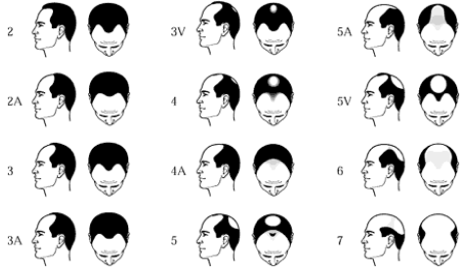How Advanced is Your Hair Loss?

Feel like you might be starting to display signs of hair loss?
Learn to recognize the stages of male pattern balding with the Norwood Scale. This guide will help you identify different types of balding patterns and measure the severity of your hair loss.
The Norwood Scale is a commonly used visual tool that displays and rates the way hair loss typically evolves in men (male pattern baldness or androgenic alopecia). It can help you keep track of your hair loss and catch the first signs of male pattern baldness.
The Norwood Scale (sometimes referred to as the Norwood-Hamilton Scale, created by O’Tar Norwood and James Hamilton):

How might familiarity with the Norwood Scale matter to you?
This is useful because the sooner you recognize the warning signs and take action, the better your chances of hanging on to your hair.
Ideally, you’ll want to start a treatment program within the first few stages to get the best results—and the more likely you’ll be able to stave off further hair loss or slow the progression.
In more advanced stages, it can still be possible to help stop further hair loss and potentially even regrow some hair, but success may be limited with non-surgical hair restoration treatments alone.
Here are some common stages of hair loss, as classified on the Norwood Scale (and a brief description):
Stage I: light hair loss. Hair around the temples may begin thinning. The frontal hairline has not shifted or may start to recede slightly, but may go unnoticed. No major changes to the hair on the crown.
Stage II: the hairline starts to recede slightly on the forehead or temples, potentially creating a triangle shape or M-shaped hairline. In these areas, hair can begin to fall out or become thin.
Stage III: receding hairline become deeper and more pronounced. You may see more thinning of hair on the crown. Balding spots may begin to develop.
Stage IV: noticeable bald spots develop on the top of the head, and you may start losing large patches of hair in the back or front of your head. Hair on your crown begins to thin and your hairline may recede further. At this stage, it’s evident that you’re experiencing male pattern baldness.
Stage V: hair loss is entering a severe stage where it becomes more difficult to treat. Early signs of the horseshoe-shaped hairline begin to appear.
Stage VI: a large portion of hair is already lost; what little hair remains on your crown is thin and provides minimal coverage of your scalp.
Stage VII: the most serious degree of baldness. Hair on the top of your head is almost completely absent. You remaining hair continues to fall out and may have a horseshoe shape.
A Final Note
When you’re considering treatment, the Norwood Scale can help you better understand and assess what stage you may be in and how far you hair loss has progressed.
Keep in mind, the Norwood Scale was designed to categorize common balding types and their typical progression, however, this can differ greatly from one individual to the next. The same is also true for the process of how your own balding progresses.
Of course, you’ll want to consult a doctor to assess your individual situation and help determine the best hair restoration options available for you.
Ready to take action? Whatever your hair situation, we can help you find a hair restoration plan that’s an optimal fit. Call to schedule your consultation today.
